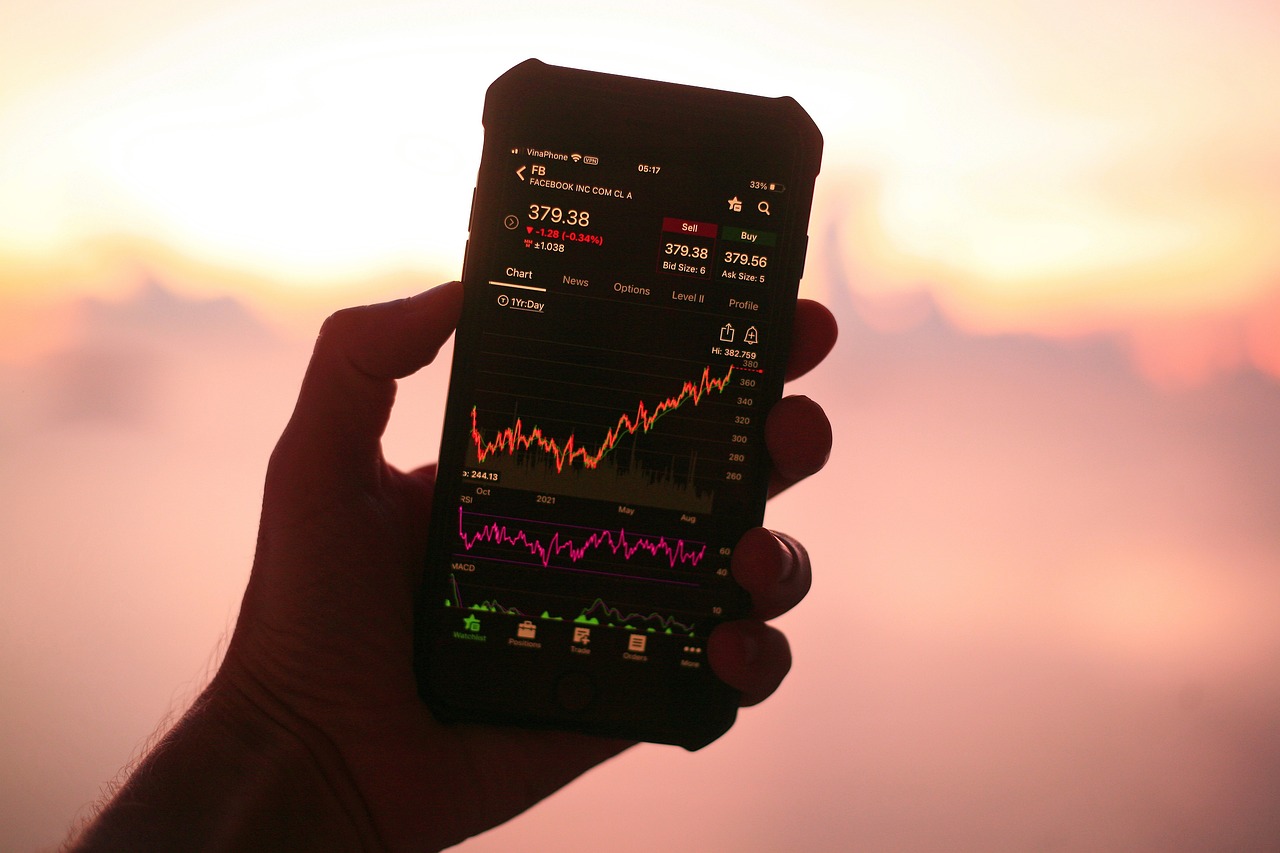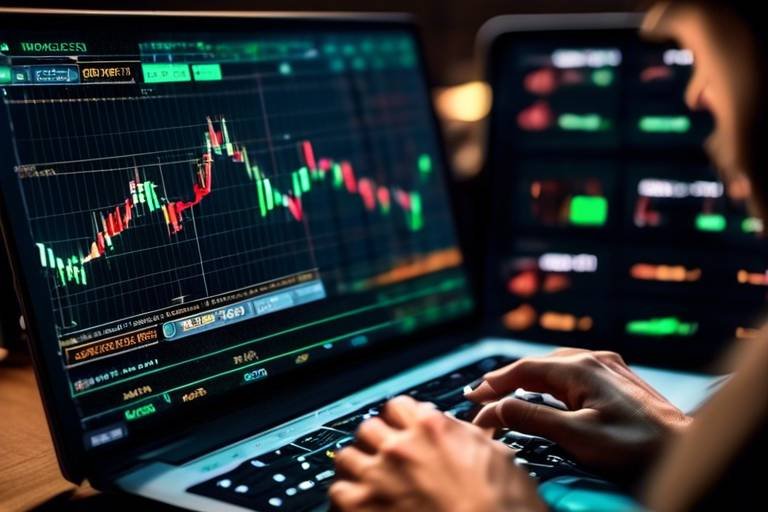How to Use Technical Indicators for Crypto Trading
In the fast-paced world of cryptocurrency trading, making informed decisions can feel like trying to find a needle in a haystack. With prices fluctuating wildly and new coins popping up daily, how do you navigate this chaotic landscape? Enter technical indicators—your trusty compass in the world of crypto trading. These tools, rooted in mathematics and market psychology, can significantly enhance your trading strategies, allowing you to spot trends, gauge momentum, and make educated predictions about future price movements. In this article, we will delve into the various types of technical indicators and how they can empower your trading journey.
At its core, a technical indicator is a mathematical calculation based on historical price and volume data. Think of them as the breadcrumbs left behind by the market, leading you to a clearer understanding of where things might be heading. By analyzing these indicators, traders can identify market trends, potential reversals, and even the overall strength of a particular asset. It's like having a crystal ball that, while not perfect, provides valuable insights into the market's behavior.
When it comes to technical indicators, there’s no one-size-fits-all solution. Different indicators serve unique purposes and can be categorized into several types:
- Trend Indicators: These help you identify the direction of the market.
- Momentum Indicators: These assess the speed of price changes.
- Volatility Indicators: These measure the price fluctuations.
- Volume Indicators: These analyze trading volume to confirm trends.
Each type plays a crucial role in developing a robust trading strategy, allowing traders to adapt to changing market conditions.
Trend indicators are like a map that shows you where the market is headed. They help traders determine whether the market is in an upward, downward, or sideways trend. By understanding the trend, you can align your trades accordingly—buying in an uptrend and selling in a downtrend. This alignment is key to maximizing profits and minimizing losses.
One of the most popular trend indicators is the moving average. This tool smooths out price data over a specific period, allowing traders to filter out the noise and focus on the overall direction. For instance, a 50-day moving average can help you see the general trend of an asset over the past two months. If the price is above the moving average, it might indicate a bullish trend, while a price below could signal a bearish trend.
Another essential trend indicator is the Average Directional Index (ADX). This tool measures the strength of a trend, regardless of its direction. A rising ADX indicates a strong trend, whether up or down, while a falling ADX suggests a weakening trend. By keeping an eye on the ADX, traders can better position themselves to capitalize on strong market movements.
Momentum indicators are like the speedometers of the trading world. They assess how quickly prices are changing, helping traders identify potential reversal points. For example, if a cryptocurrency's price is skyrocketing but the momentum is starting to wane, it could be a sign that a reversal is on the horizon. This insight is invaluable for traders looking to time their entries and exits more effectively.
Volume indicators are another crucial component of technical analysis. They analyze trading volume to confirm trends and potential reversals. After all, a price movement backed by strong volume is often more reliable than one that lacks support. Understanding volume can provide insights into market strength and trader interest, helping you make more informed decisions.
The On-Balance Volume (OBV) indicator is a popular choice among traders. It uses volume flow to predict changes in stock price, helping you understand whether buying or selling pressure is dominating the market. If the OBV is rising, it suggests that buyers are in control, potentially leading to higher prices.
This indicator assesses the cumulative flow of volume, indicating whether a security is being accumulated or distributed. A rising Accumulation/Distribution Line suggests that accumulation is occurring, which could signal potential price increases. Conversely, a declining line may indicate distribution, hinting at possible price declines.
Using multiple technical indicators together can provide a more comprehensive view of market conditions. By combining different types of indicators, you can enhance the accuracy of your trading signals and reduce the likelihood of false positives. It’s like assembling a puzzle; each piece contributes to the bigger picture, allowing for a clearer understanding of market dynamics.
A well-defined trading strategy that incorporates various indicators can help you manage risks and improve your chances of success in the volatile crypto market. Think of it as your trading blueprint—outlining when to enter, when to exit, and how to react to market changes. The clearer your strategy, the less likely you are to be swayed by emotions during trading.
Backtesting is like a rehearsal for your trading strategy. By evaluating its effectiveness using historical data, you can ensure that your approach is grounded in proven performance metrics. This process can help you identify potential weaknesses in your strategy, allowing you to make adjustments before risking real capital.
Q: What are technical indicators?
A: Technical indicators are mathematical calculations based on historical price and volume data, used to analyze market trends and predict future price movements.
Q: Why should I use technical indicators for crypto trading?
A: They provide valuable insights into market behavior, helping you make informed trading decisions and improve your overall trading strategy.
Q: Can I rely solely on technical indicators?
A: While they are powerful tools, it's essential to combine them with other forms of analysis and market research for the best results.

Understanding Technical Indicators
Technical indicators are the bread and butter of trading strategies, especially in the fast-paced world of cryptocurrency. They are essentially mathematical calculations derived from historical price and volume data. Think of them as your compass in the vast ocean of market fluctuations, guiding you towards informed decisions. By analyzing these indicators, traders can uncover market trends and make educated predictions about where prices might head next.
When you dive into the realm of technical indicators, you'll find that they can be categorized into several types, each serving a distinct purpose. This categorization helps traders pinpoint specific aspects of market behavior. Here’s a quick breakdown:
- Trend Indicators: These indicators help you identify the overall direction of the market—upwards, downwards, or sideways.
- Momentum Indicators: These assess the speed of price changes, allowing traders to spot potential reversal points.
- Volatility Indicators: They measure the degree of price fluctuations, helping traders understand market uncertainty.
- Volume Indicators: These analyze trading volume to confirm trends and potential reversals.
Understanding these indicators is crucial because they provide insights that can significantly enhance your trading strategies. For instance, if you notice a strong upward trend indicated by a trend indicator, you might decide to enter a long position. Conversely, if a momentum indicator signals that a price reversal is imminent, it might be wise to exit your position or even short the asset.
In essence, technical indicators serve as analytical tools that transform raw data into actionable insights. They help traders sift through the noise of market fluctuations and focus on what truly matters—price movements and trading volume. By mastering these indicators, you can elevate your trading game and navigate the complex world of cryptocurrency with confidence.

Types of Technical Indicators
When diving into the world of crypto trading, understanding the is crucial for crafting effective strategies. These indicators are like the compass guiding traders through the often-turbulent waters of the cryptocurrency market. They help in identifying trends, measuring momentum, analyzing volatility, and assessing volume. Each type serves a unique purpose, and knowing how to leverage them can significantly enhance your trading outcomes.
Let's break down the primary categories of technical indicators:
- Trend Indicators: These indicators help traders determine the overall direction of the market. Are prices moving up, down, or sideways? Knowing the trend is like having a map; it guides your trading decisions.
- Momentum Indicators: These tools assess the speed at which prices are changing. They can signal potential reversal points, allowing traders to capitalize on price movements before they happen.
- Volatility Indicators: These indicators measure the degree of price fluctuation. High volatility can mean greater risk but also greater opportunity for profit.
- Volume Indicators: Analyzing trading volume can provide insights into the strength of a trend or potential reversals. They help traders gauge whether buying or selling pressure is dominating the market.
Each of these indicators plays a vital role in a trader's toolkit. For instance, trend indicators are essential for identifying the market's direction, while momentum indicators help traders understand the strength of that movement. Volatility indicators can warn traders when the market is likely to make significant moves, and volume indicators confirm the strength of those moves. By combining these indicators, traders can develop a more comprehensive view of market conditions, enabling them to make informed decisions.
In summary, understanding the different types of technical indicators is like having a well-stocked toolbox. Each tool serves a specific purpose, and knowing when and how to use them can make all the difference in your trading success. Whether you're a novice or an experienced trader, mastering these indicators can lead to more strategic and profitable trading.

Trend Indicators
Trend indicators are like your trusty compass in the wild world of crypto trading. They guide you through the chaotic market landscape, helping you pinpoint whether the price of a cryptocurrency is on an upward trajectory, heading downwards, or simply moving sideways. Understanding these indicators is essential for traders who want to make informed decisions rather than gamble on market movements. After all, who wouldn’t want to navigate the crypto jungle with a reliable tool?
One of the most popular trend indicators is the Moving Average. Think of moving averages as a way to smooth out the jagged edges of price fluctuations. By averaging prices over a specific period—be it days, weeks, or even months—traders can better identify the overall direction of the market. For instance, if the 50-day moving average is above the 200-day moving average, it often signals a bullish trend. Conversely, when the 50-day moving average dips below the 200-day, it could indicate a bearish trend. This simple yet effective tool allows traders to filter out the noise and focus on the bigger picture.
Another powerful trend indicator is the Average Directional Index (ADX). Unlike other indicators that merely show the direction of the trend, the ADX measures the strength of that trend, regardless of whether it’s going up or down. Picture the ADX as a weather vane—it tells you not just which way the wind is blowing but also how strong that wind is. A rising ADX line indicates a strengthening trend, while a falling ADX suggests a weakening trend. For traders, this information is invaluable, as it helps them decide when to enter or exit a position.
To summarize, trend indicators are crucial for anyone serious about crypto trading. They help you make sense of market movements and can significantly enhance your trading strategies. By using tools like moving averages and the ADX, you can navigate the volatile waters of cryptocurrency with more confidence. Remember, in the world of trading, knowledge is power, and these indicators are your allies in the quest for profitable trades.

Moving Averages
Moving averages are one of the most popular and widely used technical indicators in the world of crypto trading. They serve as a vital tool for traders aiming to decipher the chaotic nature of price movements. Essentially, a moving average smooths out price data over a specified period, allowing traders to filter out the daily fluctuations and focus on the underlying trend. Think of it like a calm lake reflecting the sky; the ripples of daily price changes are smoothed out, revealing a clearer picture of the market's direction.
There are two primary types of moving averages that traders often utilize: the Simple Moving Average (SMA) and the Exponential Moving Average (EMA). The SMA calculates the average price over a specific number of periods, giving equal weight to all prices in that time frame. In contrast, the EMA places more emphasis on the most recent prices, making it more responsive to new information. This difference can be crucial, especially in the fast-paced world of cryptocurrency, where prices can change in the blink of an eye.
To illustrate how moving averages can be applied, consider the following table that summarizes their characteristics:
| Type of Moving Average | Calculation Method | Best For |
|---|---|---|
| Simple Moving Average (SMA) | Average price over a set period | Identifying long-term trends |
| Exponential Moving Average (EMA) | Weighted average with more emphasis on recent prices | Spotting short-term trends |
Using moving averages in your trading strategy can significantly enhance your ability to make informed decisions. For instance, traders often look for crossovers between different moving averages as potential buy or sell signals. When a shorter-term moving average crosses above a longer-term moving average, it might indicate a bullish trend, while the opposite crossover could signal a bearish trend. This simple yet effective strategy can help traders navigate the often turbulent waters of crypto markets.
Moreover, moving averages can also act as dynamic support and resistance levels. When the price approaches a moving average from above, it may find support at that level, while resistance may occur when the price approaches from below. This behavior can provide traders with additional insights into potential entry and exit points, making moving averages an indispensable part of any trader's toolkit.
In summary, moving averages are not just numbers on a chart; they are essential indicators that can help traders discern market trends and make educated decisions. By understanding how to utilize both the SMA and EMA effectively, traders can improve their chances of navigating the complexities of the crypto trading landscape.
- What is the primary purpose of moving averages in crypto trading? Moving averages help traders identify trends and potential reversal points by smoothing out price data.
- How do I choose the right period for a moving average? The choice of period depends on your trading style; shorter periods are better for day trading, while longer periods suit swing trading.
- Can moving averages be used in conjunction with other indicators? Absolutely! Combining moving averages with other indicators can enhance your trading strategy and improve accuracy.

Average Directional Index (ADX)
The is a powerful tool in the arsenal of crypto traders, providing insights into the strength of a trend, regardless of its direction. Imagine you're sailing on a vast ocean; the ADX acts as your compass, guiding you through turbulent waters by indicating whether you should hoist your sails or steer clear of rough seas. This indicator ranges from 0 to 100, with higher values indicating a stronger trend. A common interpretation is that an ADX value above 25 suggests a strong trend, while values below 20 indicate a weak or non-existent trend.
To better understand how the ADX functions, it’s essential to consider its components: the +DI (Positive Directional Indicator) and the -DI (Negative Directional Indicator). These two indicators work hand in hand with the ADX to provide a clearer picture of market conditions. When the +DI crosses above the -DI, it suggests a potential buying opportunity, signaling that upward momentum is gaining strength. Conversely, when the -DI crosses above the +DI, it indicates that selling pressure may be on the rise, presenting a potential selling opportunity.
Here's a quick overview of how to interpret the ADX values:
| ADX Value | Interpretation |
|---|---|
| 0 - 20 | Weak trend or sideways market |
| 20 - 25 | Potential trend beginning |
| 25 - 50 | Strong trend |
| 50 - 75 | Very strong trend |
| 75 - 100 | Extreme trend conditions |
Using the ADX effectively requires a combination of patience and practice. It's not just about the numbers; it's about understanding the market dynamics that those numbers represent. For instance, during periods of high volatility, the ADX can provide crucial insights into whether to enter or exit a position. However, traders should also be wary of false signals, especially when the market is choppy. It’s often beneficial to combine the ADX with other indicators, such as moving averages or momentum indicators, to confirm your trading decisions.
In conclusion, the Average Directional Index is not just another line on your chart; it's a vital indicator that can help you navigate the complexities of crypto trading. By understanding its signals and incorporating it into your trading strategy, you can enhance your ability to make informed decisions in a fast-paced market.
- What is the best ADX value to use for trading? Generally, an ADX value above 25 is considered strong, indicating a trending market.
- Can the ADX be used for all types of trading? Yes, the ADX can be applied to various trading styles, including day trading, swing trading, and long-term investing.
- How often should I check the ADX? It's advisable to monitor the ADX regularly, especially during significant market movements or when entering new positions.

Momentum Indicators
Momentum indicators are essential tools in the arsenal of any crypto trader, as they help gauge the speed and strength of price movements. Imagine you're on a roller coaster; the thrill comes not just from the height but from the speed at which you plunge downwards. Similarly, momentum indicators allow traders to capture that exhilarating rush of price changes in the cryptocurrency market. By measuring the rate at which prices are moving, these indicators provide insights into whether a cryptocurrency is gaining or losing momentum, which can be crucial for making timely trading decisions.
One of the most popular momentum indicators is the Relative Strength Index (RSI). The RSI operates on a scale of 0 to 100, helping traders identify overbought or oversold conditions. When the RSI crosses above 70, it often indicates that a cryptocurrency is overbought, suggesting a potential price correction. Conversely, an RSI below 30 signals that the asset may be oversold, presenting a potential buying opportunity. This duality of the RSI is akin to a pendulum swinging, where traders must decide when to jump in or out based on the momentum it indicates.
Another key momentum indicator is the Moving Average Convergence Divergence (MACD). The MACD consists of two moving averages that converge and diverge, providing traders with signals about potential buy and sell opportunities. When the MACD line crosses above the signal line, it often indicates bullish momentum, while a cross below may suggest bearish momentum. This can be visualized as a dance between two partners, where their movements signal when to step forward or retreat.
To effectively utilize momentum indicators, traders often combine them with other tools to create a more robust trading strategy. For example, using the RSI in conjunction with the MACD can provide a clearer picture of market conditions. Consider this as assembling a jigsaw puzzle; each piece represents an indicator, and only by fitting them together can you see the entire picture of market dynamics.
Additionally, it’s crucial to remember that momentum indicators, while powerful, are not foolproof. They can generate false signals, particularly in volatile markets like cryptocurrencies. Thus, traders should always confirm momentum signals with other indicators or fundamental analysis to avoid being misled. Just like a seasoned sailor checks the weather before setting sail, traders must ensure that their momentum indicators align with broader market trends and conditions.
In conclusion, momentum indicators are like the heartbeat of the crypto market, providing traders with vital signs of price action. By understanding and effectively utilizing these tools, traders can enhance their decision-making processes and potentially improve their trading outcomes. As you dive deeper into the world of crypto trading, remember that the key to success lies in not just recognizing momentum but also knowing how to ride its waves skillfully.

Using Volume Indicators
When it comes to crypto trading, volume indicators are like the pulse of the market. They provide essential insights into the strength of price movements and help traders gauge the level of interest in a particular asset. Think of volume as the crowd at a concert; a larger crowd indicates greater interest and excitement, while a smaller crowd suggests a lack of enthusiasm. In the world of trading, understanding volume can be the difference between riding a wave of profit and getting caught in a downturn.
Volume indicators analyze the number of shares or contracts traded over a specific period, allowing traders to confirm trends and identify potential reversals. For instance, if a cryptocurrency is experiencing a price increase accompanied by high trading volume, it signals that the upward trend is likely to continue. Conversely, if prices rise but volume is low, it may indicate a lack of conviction among traders, suggesting that the trend could reverse.
Two popular volume indicators that traders often utilize are the On-Balance Volume (OBV) and the Accumulation/Distribution Line. The OBV is particularly interesting because it combines price and volume to provide insights into whether buying or selling pressure is dominating the market. A rising OBV indicates that buyers are more aggressive, while a falling OBV suggests that sellers are taking control. This can be a powerful signal for traders looking to enter or exit positions.
On the other hand, the Accumulation/Distribution Line offers a cumulative view of volume flow, helping traders determine whether an asset is being accumulated (bought) or distributed (sold). If the line is rising, it indicates that accumulation is taking place, which can be a bullish sign. Conversely, a declining line suggests distribution, potentially signaling a bearish trend. Understanding these indicators can provide traders with a clearer picture of market sentiment and help them make informed decisions.
| Volume Indicator | Purpose | Signal Interpretation |
|---|---|---|
| On-Balance Volume (OBV) | Measures buying and selling pressure | Rising OBV bullish, Falling OBV bearish |
| Accumulation/Distribution Line | Tracks cumulative volume flow | Rising line accumulation (bullish), Falling line distribution (bearish) |
Incorporating volume indicators into your trading strategy can enhance your analysis and improve your decision-making process. By observing how volume interacts with price movements, you can gain a deeper understanding of market dynamics. Remember, it's not just about the price; the volume tells a story of its own. So, the next time you're analyzing a cryptocurrency, take a moment to consider the volume—after all, it might just be the key to unlocking your trading potential!
- What is a volume indicator? A volume indicator measures the number of shares or contracts traded in a specific period, helping traders gauge market strength.
- How do I use volume indicators in trading? Volume indicators can confirm trends, signal potential reversals, and provide insights into market sentiment when combined with price analysis.
- Are volume indicators reliable? While no indicator is foolproof, volume indicators can enhance your trading strategy by providing additional context to price movements.

On-Balance Volume (OBV)
The is a powerful technical indicator that helps traders gauge the buying and selling pressure in the market. Unlike other indicators that focus solely on price movements, OBV takes into account the volume of trades, which is crucial in understanding market sentiment. The core idea behind OBV is simple: it adds volume on up days and subtracts volume on down days. This cumulative total provides insight into whether the market is experiencing more buying or selling pressure over time.
Imagine you're at a concert, and you can feel the energy of the crowd. If more people are cheering and jumping up and down (buying), the atmosphere is electric, and you can sense that the band is about to play their hit song. Conversely, if the crowd is sitting down and looking bored (selling), the energy dips, indicating that the show might not go as well. Similarly, OBV helps you feel the pulse of the market. When OBV is rising, it suggests that the volume of buying is increasing, which typically precedes price increases. On the flip side, a declining OBV indicates growing selling pressure, often foreshadowing price drops.
One of the key advantages of using OBV is its ability to confirm trends. For instance, if the price of a cryptocurrency is rising while the OBV is also increasing, it strengthens the validity of the upward trend. Conversely, if prices are climbing but OBV is falling, it raises a red flag, suggesting that the rally might not have solid backing. This divergence can be a crucial signal for traders, prompting them to reassess their positions.
To illustrate how OBV works, consider the following table that summarizes the calculation process:
| Day | Closing Price | Volume | OBV Change | Cumulative OBV |
|---|---|---|---|---|
| 1 | $100 | 500 | +500 | 500 |
| 2 | $102 | 600 | +600 | 1100 |
| 3 | $101 | 400 | -400 | 700 |
| 4 | $103 | 800 | +800 | 1500 |
In this example, you can see how the OBV changes based on the closing price and volume. On Day 1, the price is $100 with a volume of 500, so the OBV starts at 500. On Day 2, the price rises to $102, and the volume increases to 600, pushing the OBV up to 1100. However, on Day 3, when the price dips to $101, the volume is lower, resulting in a decrease in OBV. This fluctuation provides traders with valuable insights into market dynamics.
In conclusion, the On-Balance Volume indicator is an essential tool for any crypto trader looking to enhance their trading strategy. By considering both price movements and trading volume, OBV helps traders make more informed decisions, whether they are entering or exiting a position. Remember, the key to successful trading lies not just in understanding the indicators but also in combining them effectively to create a robust trading strategy.
- What is the significance of OBV in crypto trading? OBV helps traders understand market trends by analyzing volume alongside price movements, providing insights into buying and selling pressure.
- Can OBV be used for all cryptocurrencies? Yes, OBV can be applied to any cryptocurrency as long as there is sufficient trading volume available.
- How can I combine OBV with other indicators? You can use OBV in conjunction with trend indicators like moving averages or momentum indicators to confirm signals and enhance your trading strategy.

Accumulation/Distribution Line
The is a powerful technical indicator that helps traders understand the cumulative flow of volume in relation to price movements. Essentially, it provides insights into whether a particular asset is being accumulated (bought) or distributed (sold) over time. This is crucial for traders who want to gauge market sentiment and make informed decisions. Imagine trying to read the mood of a crowd; the Accumulation/Distribution Line acts as your magnifying glass, revealing whether the crowd is cheering for a stock or booing it off the stage.
To calculate the Accumulation/Distribution Line, traders take into account both the closing price and the volume for a given period. The formula is straightforward, yet effective:
Accumulation/Distribution Line Previous A/D Line + [(Close - Low) - (High - Close)] / (High - Low) * Volume
This formula highlights the relationship between price movement and volume, allowing traders to identify divergences that can signal potential trend reversals. For instance, if the price is rising while the A/D Line is falling, it could indicate that the upward movement lacks strong buying support, suggesting a possible reversal. Conversely, if the price is declining but the A/D Line is rising, it could mean that there is underlying buying interest, hinting at a potential bullish reversal.
Understanding the nuances of the Accumulation/Distribution Line can significantly enhance your trading strategy. Here are a few key points to consider:
- Trend Confirmation: A rising A/D Line confirms an uptrend, while a falling A/D Line supports a downtrend.
- Divergence Signals: Look for divergences between price and the A/D Line to spot potential reversals.
- Volume Analysis: Higher volume on up days compared to down days indicates accumulation, while the opposite suggests distribution.
In a nutshell, the Accumulation/Distribution Line is an essential tool for traders looking to analyze market sentiment and make data-driven decisions. By combining this indicator with others, you can develop a more robust trading strategy that takes into account both price action and volume dynamics.
- What is the purpose of the Accumulation/Distribution Line?
The Accumulation/Distribution Line helps traders understand the flow of volume in relation to price movements, indicating whether an asset is being accumulated or distributed. - How do I interpret divergences in the A/D Line?
Divergences occur when the price moves in one direction while the A/D Line moves in the opposite direction. This can signal potential trend reversals. - Can I use the A/D Line with other indicators?
Absolutely! Combining the A/D Line with other technical indicators can provide a more comprehensive view of market conditions and enhance trading accuracy.

Combining Indicators for Better Analysis
When it comes to crypto trading, relying on a single technical indicator can sometimes lead you down the wrong path. Think of it like trying to navigate a new city with just one map; while it might get you somewhere, it won't give you the full picture. By combining multiple indicators, you can create a more robust analysis that enhances your trading decisions. This approach allows you to verify signals and gain deeper insights into market movements.
For instance, consider pairing trend indicators, like Moving Averages, with momentum indicators such as the Relative Strength Index (RSI). The Moving Average can help you identify the overall direction of the market, while the RSI can signal whether the asset is overbought or oversold. This combination can provide a clearer picture of when to enter or exit a position, reducing the chances of making impulsive decisions based on incomplete data.
Moreover, using volume indicators alongside other types can significantly improve your analysis. Volume indicators, such as On-Balance Volume (OBV), can confirm the strength of a trend identified by your trend indicators. If your Moving Average indicates a bullish trend but the OBV shows low volume, it might be a signal that the trend lacks conviction. This kind of insight is crucial for making informed trading decisions.
Here’s a simple example of how combining indicators can work:
| Indicator Type | Indicator | Purpose |
|---|---|---|
| Trend Indicator | Moving Average | Identifies the overall direction of the market. |
| Momentum Indicator | RSI | Indicates overbought or oversold conditions. |
| Volume Indicator | On-Balance Volume (OBV) | Confirms trend strength and buying/selling pressure. |
By analyzing the interplay between these indicators, traders can make more informed decisions. However, it’s essential to remember that no combination is foolproof. Market conditions can change rapidly, and it's crucial to remain adaptable. Regularly reviewing your indicators and adjusting your strategy based on current market conditions can be the key to long-term success in crypto trading.
Ultimately, combining indicators not only provides a more comprehensive view of the market but also helps traders to manage risks more effectively. By understanding how different indicators interact, you can craft a trading strategy that aligns with your goals and risk tolerance, paving the way for improved trading outcomes.
- What are technical indicators?
Technical indicators are mathematical calculations based on historical price and volume data that help traders analyze market trends and predict future price movements.
- How do I choose the right indicators for my trading strategy?
Choosing the right indicators depends on your trading style, objectives, and the specific market conditions. It's often beneficial to combine different types of indicators for a well-rounded analysis.
- Can I rely solely on technical indicators for trading decisions?
While technical indicators are valuable tools, they should not be the only factor in your trading decisions. It's important to consider fundamental analysis and market news as well.

Creating a Trading Strategy
Creating a successful trading strategy in the volatile world of cryptocurrency is akin to crafting a recipe—every ingredient matters, and the right balance can lead to a delicious outcome. A well-defined strategy not only helps you navigate the unpredictable market but also equips you with the tools to manage risks effectively. So, how do you go about creating your own trading strategy? Let’s break it down step by step.
First and foremost, it's essential to set your trading goals. Are you looking to make quick profits through day trading, or are you more interested in long-term investments? Defining your objectives will help shape your strategy. Once you have a clear goal in mind, consider the following components:
- Market Analysis: This involves studying market trends and understanding the underlying factors that influence price movements. Utilize technical indicators to analyze historical data and forecast future trends.
- Risk Management: Determine how much capital you are willing to risk on each trade. A common rule is to risk only 1-2% of your trading capital on a single trade. This approach helps protect your portfolio from significant losses.
- Entry and Exit Points: Clearly define when you will enter and exit trades. Use technical indicators such as moving averages or momentum indicators to identify these points. Having a plan in place will prevent emotional decision-making.
- Review and Adjust: The market is constantly changing, and so should your strategy. Regularly review your trades to identify what works and what doesn’t. Adjust your strategy based on your findings to enhance its effectiveness.
Now, let’s take a closer look at how these components come together in a cohesive trading strategy. Imagine you’re a chef preparing a gourmet meal. You wouldn’t just throw ingredients into a pot without a plan, right? Similarly, your trading strategy should follow a structured approach:
| Component | Description |
|---|---|
| Market Analysis | Study market trends and use technical indicators to forecast price movements. |
| Risk Management | Set a risk percentage for each trade to protect your capital. |
| Entry/Exit Points | Define specific conditions for entering and exiting trades. |
| Review/Adjust | Regularly analyze past trades and adjust your strategy accordingly. |
Incorporating these elements into your strategy creates a robust framework that can adapt to market fluctuations. However, remember that no strategy is foolproof. The cryptocurrency market is notorious for its volatility, and even the best-laid plans can go awry. This is where the importance of backtesting comes into play. By using historical data to simulate your strategy, you can gain insights into its potential effectiveness before risking real capital.
Ultimately, developing a trading strategy is a personal journey. It requires patience, discipline, and a willingness to learn from both successes and failures. Just like a seasoned chef perfecting a signature dish, you’ll refine your strategy over time, adjusting ingredients and techniques until you find what works best for you. So, roll up your sleeves, get your tools ready, and start crafting your unique trading strategy today!
Q: How long should I backtest my trading strategy?
A: Ideally, you should backtest your strategy over several market cycles to ensure its robustness. A minimum of six months to a year of historical data is often recommended.
Q: Can I use the same strategy for all cryptocurrencies?
A: While the core principles of your strategy can remain the same, it’s important to tailor your approach based on the specific characteristics of each cryptocurrency, such as volatility and trading volume.
Q: What is the best time frame for trading?
A: The best time frame depends on your trading style. Day traders may prefer shorter time frames (like 5-minute or 15-minute charts), while swing traders might look at daily or weekly charts.

Backtesting Your Strategy
Backtesting your trading strategy is like taking a time machine back to the past to see how your approach would have fared in real market conditions. It’s an essential step for any trader who wants to ensure that their strategy isn’t just a shot in the dark but is based on solid data and proven effectiveness. By simulating trades using historical data, you can evaluate how well your indicators would have performed, allowing you to tweak and refine your strategy before risking real money.
Imagine you’ve designed a strategy that combines several technical indicators, such as moving averages and the Average Directional Index (ADX). By backtesting, you can see how this combination would have reacted during different market conditions—whether the market was bullish, bearish, or sideways. This insight is invaluable because it helps you understand not just if your strategy is profitable, but also how it behaves under various circumstances.
To backtest effectively, follow these key steps:
- Choose Your Data: Select a reliable source of historical price data for the cryptocurrency you want to trade. Ensure the data covers different market conditions to get a comprehensive view.
- Define Your Strategy: Clearly outline the rules of your strategy. What indicators will you use? What are your entry and exit points? Having a well-defined plan is crucial.
- Run the Backtest: Use backtesting software or platforms that allow you to input your strategy and historical data. The software will simulate trades based on your defined rules.
- Analyze the Results: Review the outcomes of your backtest. Look at key metrics such as win rate, average profit/loss per trade, and maximum drawdown to gauge your strategy’s effectiveness.
- Refine and Repeat: Use the insights gained from your backtest to adjust your strategy. Perhaps certain indicators need to be weighted more heavily or specific market conditions should be avoided. Once you’ve made adjustments, backtest again!
Backtesting not only helps in validating your strategy but also builds your confidence as a trader. It’s like practicing before a big game; you wouldn’t want to step onto the field without knowing your plays inside and out. Remember, though, that past performance does not guarantee future results. Markets are dynamic, and while backtesting provides valuable insights, it’s crucial to remain adaptable and continuously monitor your strategy in real-time trading conditions.
What is backtesting in trading?
Backtesting is the process of testing a trading strategy on historical data to see how it would have performed in the past. It helps traders evaluate the effectiveness of their strategies before implementing them in live markets.
Why is backtesting important?
Backtesting is important because it provides insights into how a trading strategy might perform under various market conditions. It helps traders refine their strategies and build confidence before risking real money.
What should I look for in backtest results?
Key metrics to look for include the win rate, average profit/loss per trade, maximum drawdown, and overall profitability. These metrics help assess the viability of your strategy.
Can I rely solely on backtesting for trading success?
While backtesting is a valuable tool, it should not be the only factor in your trading decisions. Markets are influenced by many unpredictable factors, so it’s essential to remain flexible and adapt your strategy as needed.
Frequently Asked Questions
- What are technical indicators in crypto trading?
Technical indicators are mathematical tools that help traders analyze market data, particularly historical price and volume. By using these indicators, traders can identify trends, make predictions about future price movements, and enhance their trading strategies.
- How do trend indicators work?
Trend indicators, like moving averages and the Average Directional Index (ADX), help traders determine the overall direction of the market. They filter out noise from daily price fluctuations, allowing traders to focus on whether the market is trending upwards, downwards, or remaining stable.
- What is the purpose of momentum indicators?
Momentum indicators measure the speed at which prices change, helping traders identify potential reversal points and gauge the strength of price movements. This can be crucial for making timely buying or selling decisions.
- Why are volume indicators important?
Volume indicators analyze the amount of trading activity to confirm trends and potential reversals. By understanding whether buying or selling pressure is dominating, traders can gain insights into market strength and trader interest.
- How can I combine different indicators for better analysis?
Combining multiple technical indicators can provide a more comprehensive view of market conditions. This approach enhances the accuracy of trading signals and helps reduce the chances of false positives, leading to more informed trading decisions.
- What should I consider when creating a trading strategy?
A solid trading strategy should incorporate various technical indicators to manage risks effectively. It's essential to define your goals, set clear entry and exit points, and be prepared to adapt your strategy based on market conditions.
- What is backtesting and why is it important?
Backtesting involves evaluating the effectiveness of a trading strategy using historical data. This process helps traders ensure their approach is based on proven performance metrics, increasing the likelihood of success in the unpredictable crypto market.



















